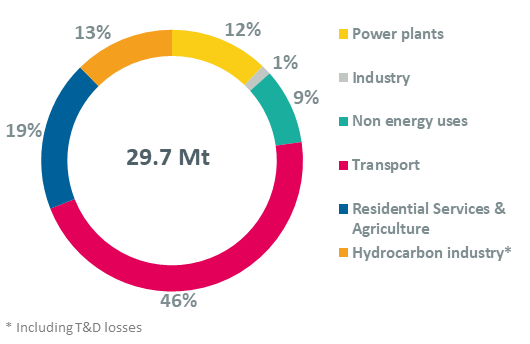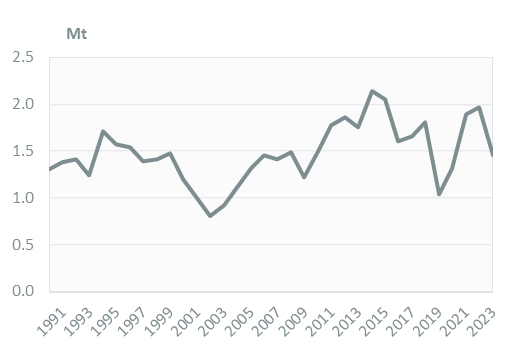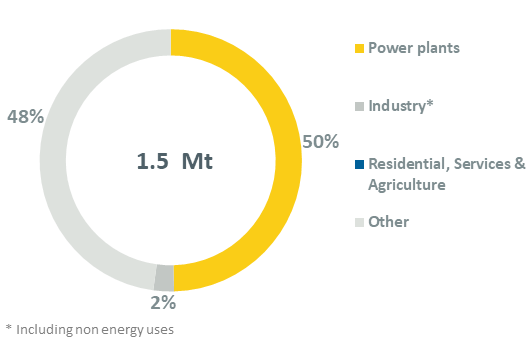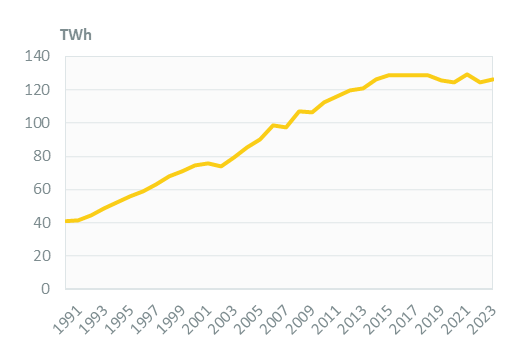-
-
 Energy and Climate Databases
Energy and Climate Databases- The most comprehensive and up-to-date annual energy database.
- Monitoring of technology providers in H2 supply chain.
- Monthly energy data on key energy markets.
- The most reliable and up-to-date power generation database.
- The essentials of LNG trade at your fingertips.
- Global monitoring of new and existing refineries.
- Analyse energy consumption and efficiency trends at world level. Benchmark countries.
- Have your database developed by a recognised expert of both energy and IT.
-
 Energy - Climate Forecasts
Energy - Climate Forecasts- Instant access to energy and emissions forecasts.
- Strategic, annual wholesale price projections backed by Enerdata's energy modelling expertise and our globally recognised POLES model.
- Wedges module showing a breakdown of the levers enabling to reduce emissions between two scenarios.
- Unique, independent projections of consumption by end-use.
- GHG Marginal Abatement Cost Curves.
- Benefit from proven models to draw your own energy scenarios and anticipate tomorrow’s challenges.
-
 Market Intelligence
Market Intelligence- 110 Energy and climate country reports
- A newsletter to receive the latest updates on evolving technologies and policies.
- Global energy news and analyses curated daily.
- Enerdata’s experts bring you the essentials about your market and competitors.
-
-
-
 Market Analysis
Market Analysis- Understanding key consumption trends and drivers across sectors.
- Granular and exclusive insight to address the most pressing business and strategic issues.
- Expertise in strategic and business intelligence, with fine-tuning to the market’s specificities.
-
 Energy - Climate Scenarios
Energy - Climate Scenarios- Providing the outlook of an energy commodity in mid to long term time horizons.
- Sector and driver specific energy demand forecasting.
- Assess the evolution of energy prices on the international and regional markets, as well as end-users prices.
- Enerdata guides you through pathways to reach climate targets.
- Supporting local authorities in their decarbonisation strategies.
-
 Climate Strategy and Policy Evaluation
Climate Strategy and Policy Evaluation- Cutting-edge quantitative tools and relevant indicators to monitor and evaluate evolutions on worldwide energy markets.
- Analysis of the most cost-effective options to reduce emissions.
- Quantified simulation and analysis of pledges for climate change negotiations.
- Breakdown and analysis of carbon markets.
- Enerdata guides you on the most beneficial policy or investment options.
- Turning climate objectives into concrete action plans.
-
 Training
Training- Understand different policy targets and measures on energy efficiency.
- How to measure energy savings?
- Energy Forecasting is a 2 days training to learn to design and interpret energy forecasts.
- Energy statistics training allowing to create energy balance with supply, transformation and consumption and understanding the international energy statistics regulations.
- Initiation to EnerMED level 1is the training to approach on the most powerful energy demand forecasting model.
-
-
Resource Centre
Argentina Key Figures
- Population:
- 46.7 million
- GDP growth rate:
- -1.6 %/year
- Energy independence:
- 100%
Data of the last year available: 2023
- Total consumption/GDP:*
- 85.1 (2005=100)
- CO2 Emissions:
- 3.54 tCO2/capita
- Rate of T&D power losses:
- 20.2%
* at purchasing power parity
View all macro and energy indicators in the Argentina energy report
Argentina Related News
View all news, archive your new and create your own daily newsletters only on your topics/countries of interest with Key Energy Intelligence
Argentina Related Research
Benefit from up to 2 000 up-to-date data series for 186 countries in Global Energy & CO2 data
A data overview is available in the global energy statistics app
Total Energy Consumption
Per capita consumption in Argentina (1.7 toe/cap in 2023) is the third highest in South America after Chile and Guyana. These high levels are mainly due to space heating needs. Electricity demand per capita is around 2 700 kWh/cap (2023).
Total energy consumption decreased by 2% in 2023 to 80 Mtoe, back to its pre-COVID-19 levels. Total consumption previously regularly increased from 2007 to a peak in 2016 (82 Mt) and decreased until 2020.
Interactive Chart Argentina Total Energy Consumption
Benefit from up to 2 000 up-to-date data series for 186 countries in Global Energy & CO2 data
View the detailed fondamentals of the market at country level (graphs, tables, analysis) in the Argentina energy report
Crude Oil Production
Oil production has jumped by 10%/year since 2021 to reach 37 Mt in 2023. Previously, it had been falling regularly from a peak level of 46 Mt in 1998 to 28 Mt in 2021. Argentina is the 4th largest oil producer in South America after Brazil, Venezuela, and Colombia.
Crude oil exports have increased since 2021 to reach 8 Mt in 2023.
The refining capacity of 635 kb/d (2023) is shared between 11 refineries. In 2012, YPF inaugurated a new diesel hydrodesulfurization unit at its La Plata refinery. The US$304m investment raised the diesel production by 13%.
Interactive Chart Argentina Crude Oil Production
Benefit from up to 2 000 up-to-date data series for 186 countries in Global Energy & CO2 data
Additionally, for more detailed information on refineries, you can request a sample of our America Refineries Dataset
Oil Products Consumption
Oil product consumption increased by 5%/year since 2021 to 30 Mt in 2023. Previously, it decreased by 4.6%/year from 2015 to 2020.
Transport absorbs 46% of that consumption.
Graph: OIL CONSUMPTION (Mt)

Graph: OIL CONSUMPTION BREAKDOWN BY SECTOR (2023, %)

Interactive Chart Argentina Refined Oil Products Production
Benefit from up to 2 000 up-to-date data series for 186 countries in Global Energy & CO2 data
Additionally, for more detailed information on refineries, you can request a sample of our America Refineries Dataset
Natural Gas Consumption
Natural gas consumption decreased by 7% in 2023 to 45 bcm. It follows the previous declining trend of around 2%/year since its peak in 2017. Prior to that, natural gas consumption increased at a rate of 1.8%/year from 2009 to 2017. Argentina is the largest gas consumer in South America ahead of Brazil.
Electricity production absorbs 32% of that consumption, followed by the residential and tertiary sector, which consume 24%, and the industrial sector (20%). Transport represents 5% of gas consumption.
Graph: NATURAL GAS CONSUMPTION (bcm)
Interactive Chart Argentina Natural Gas Domestic Consumption
Benefit from up to 2 000 up-to-date data series for 186 countries in Global Energy & CO2 data
Additionally, for more detailed information on the LNG trade, you can request a sample of our America LNG Trade Dataset
Coal Consumption
Coal consumption is very low (1.5 Mt in 2023). Half of the coal is used for power generation, while the remainder is used in industry.
Graph: COAL CONSUMPTION (Mt)

Graph: COAL CONSUMPTION BREAKDOWN BY SECTOR (2023, %)

Interactive Chart Argentina Coal and Lignite Domestic Consumption
Benefit from up to 2 000 up-to-date data series for 186 countries in Global Energy & CO2 data
View the detailed consumption trends at country level (graphs, tables, analysis) in the Argentina energy report
Power Consumption
Electricity consumption increased by 1.8% in 2023 to 127 TWh. It had been roughly stable since 2015, after a regular increase of 4.7%/year between 1990 and 2015.
The residential sector is the largest electricity consumer (39%), ahead of industry (34%) and services (25%). The services sector share has been largely stable since 2005, while households have been gaining share from industry.
Graph: ELECTRICITY CONSUMPTION (TWh)

Renewable in % Electricity Production
The Renewable Energy Act of 2015 sets the goal of increasing the share of renewables (apart from large hydro) to 20% of electricity production in 2025, with intermediate goals, which were achieved (16% in 2021 and 18% in 2023). The law includes an obligation for large consumers (above 300 kW) to achieve these targets individually with fines on large electricity users that do not meet their target.
In 2016, a law created a fund aimed at financing or buying interests in renewable power projects and enabled power purchase agreements between renewable producers and large consumers.
Interactive Chart Argentina Share of Renewables in Electricity Production (incl hydro)
Benefit from up to 2 000 up-to-date data series for 186 countries in Global Energy & CO2 data
CO2 Fuel Combustion/CO2 Emissions
In its updated NDC (2021), the country announced its aim of not exceeding 349 MteqCO2 of net GHG emissions by 2030, which is equivalent to a decrease in emissions by 19% compared to the historical peak reached in 2007. During the COP26, the country further raised its mitigation target by not exceeding 349 MtCO2e in 2030 (-21% compared to 2007). The Long-Term Strategy (LTS, 2022), and the National Energy Transition Plan to 2030 (2023) confirmed the 2050 net zero target.